Organizational Behavior Influence on Performance: Marks and Spencer
VerifiedAdded on 2023/01/11
|14
|5070
|43
Report
AI Summary
This report delves into the realm of organizational behavior, using Marks and Spencer as a case study. It begins by analyzing how an organization's culture, politics, and power dynamics impact individual and team behaviors and overall performance. The report then evaluates content and process theories of motivation, including reinforcement theory, Vroom's expectancy theory, and various motivational techniques, to assess their effectiveness in achieving organizational goals. Furthermore, it explores the characteristics that define effective and ineffective teams, providing insights into team dynamics and performance. Finally, the report applies key concepts and philosophies of organizational behavior to the context of Marks and Spencer, offering a comprehensive understanding of how these principles influence the company's operations and success.
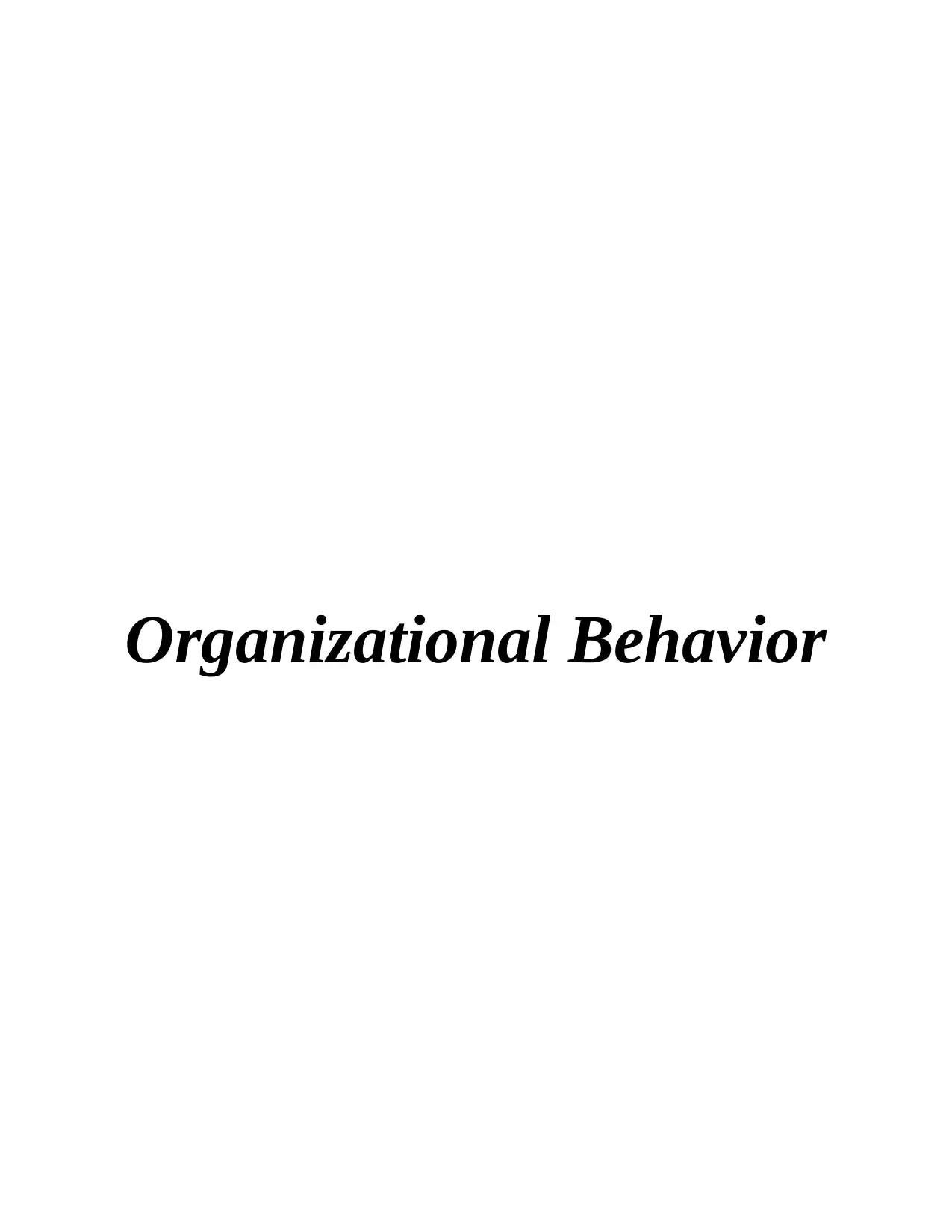
Organizational Behavior
Paraphrase This Document
Need a fresh take? Get an instant paraphrase of this document with our AI Paraphraser
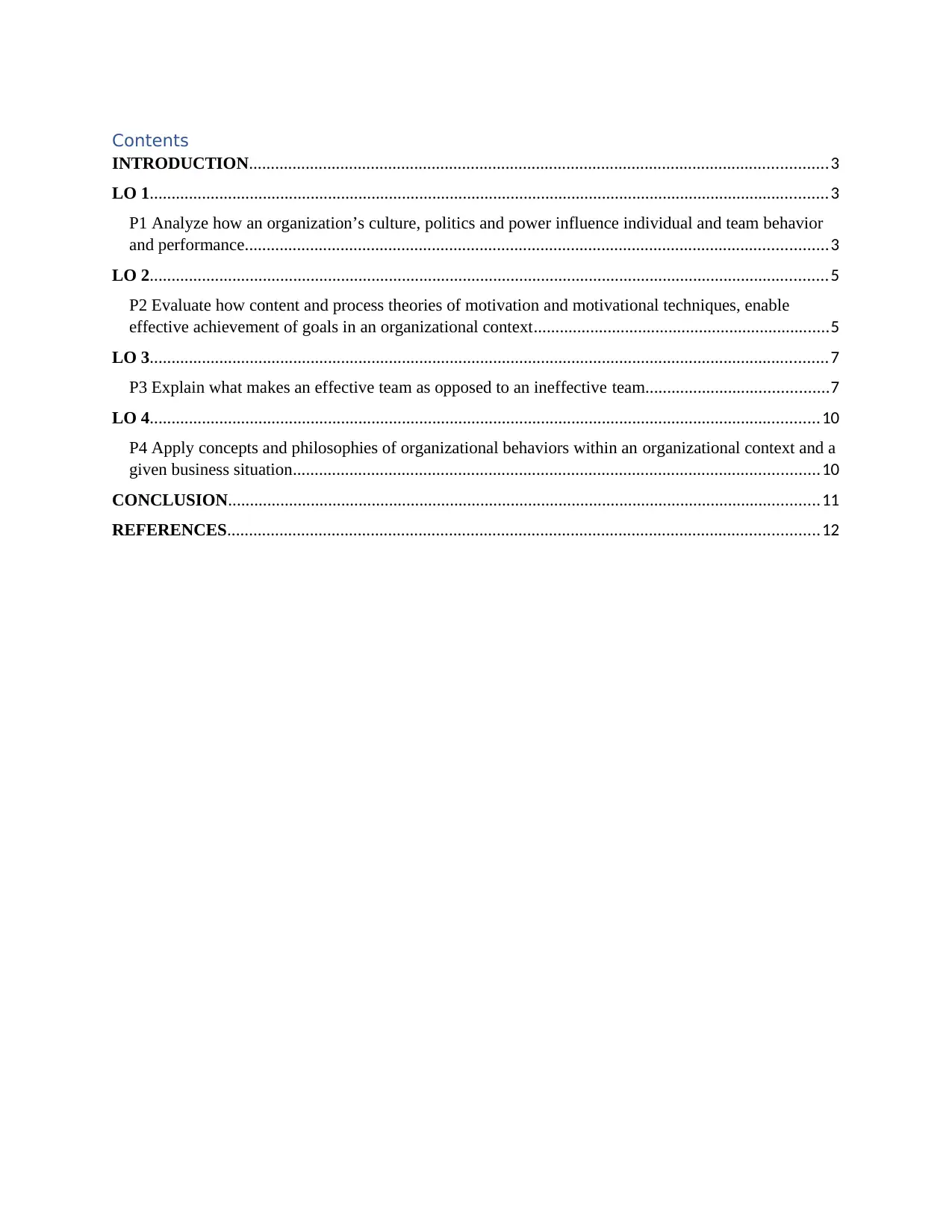
Contents
INTRODUCTION.....................................................................................................................................3
LO 1............................................................................................................................................................3
P1 Analyze how an organization’s culture, politics and power influence individual and team behavior
and performance......................................................................................................................................3
LO 2............................................................................................................................................................5
P2 Evaluate how content and process theories of motivation and motivational techniques, enable
effective achievement of goals in an organizational context....................................................................5
LO 3............................................................................................................................................................7
P3 Explain what makes an effective team as opposed to an ineffective team..........................................7
LO 4..........................................................................................................................................................10
P4 Apply concepts and philosophies of organizational behaviors within an organizational context and a
given business situation.........................................................................................................................10
CONCLUSION........................................................................................................................................11
REFERENCES........................................................................................................................................12
INTRODUCTION.....................................................................................................................................3
LO 1............................................................................................................................................................3
P1 Analyze how an organization’s culture, politics and power influence individual and team behavior
and performance......................................................................................................................................3
LO 2............................................................................................................................................................5
P2 Evaluate how content and process theories of motivation and motivational techniques, enable
effective achievement of goals in an organizational context....................................................................5
LO 3............................................................................................................................................................7
P3 Explain what makes an effective team as opposed to an ineffective team..........................................7
LO 4..........................................................................................................................................................10
P4 Apply concepts and philosophies of organizational behaviors within an organizational context and a
given business situation.........................................................................................................................10
CONCLUSION........................................................................................................................................11
REFERENCES........................................................................................................................................12
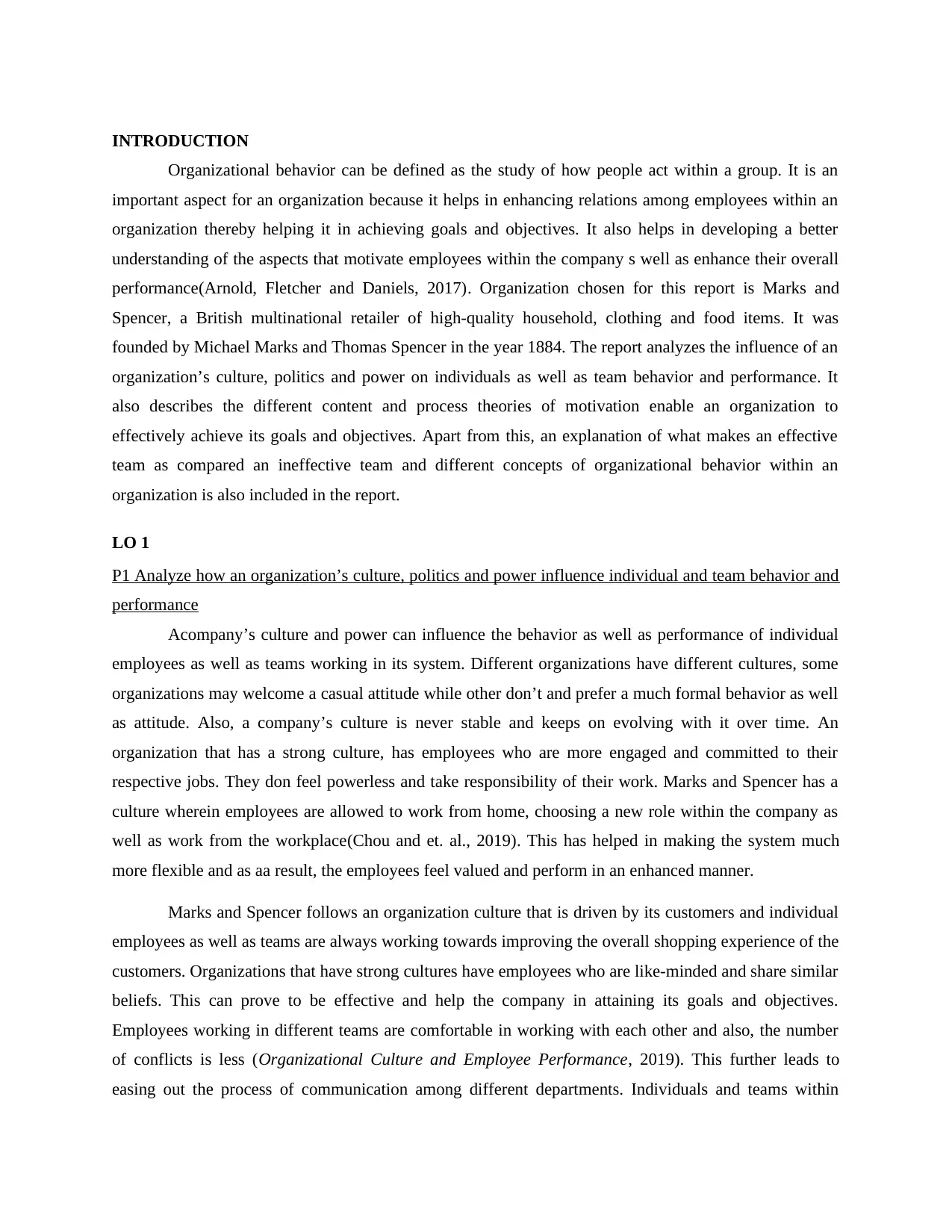
INTRODUCTION
Organizational behavior can be defined as the study of how people act within a group. It is an
important aspect for an organization because it helps in enhancing relations among employees within an
organization thereby helping it in achieving goals and objectives. It also helps in developing a better
understanding of the aspects that motivate employees within the company s well as enhance their overall
performance(Arnold, Fletcher and Daniels, 2017). Organization chosen for this report is Marks and
Spencer, a British multinational retailer of high-quality household, clothing and food items. It was
founded by Michael Marks and Thomas Spencer in the year 1884. The report analyzes the influence of an
organization’s culture, politics and power on individuals as well as team behavior and performance. It
also describes the different content and process theories of motivation enable an organization to
effectively achieve its goals and objectives. Apart from this, an explanation of what makes an effective
team as compared an ineffective team and different concepts of organizational behavior within an
organization is also included in the report.
LO 1
P1 Analyze how an organization’s culture, politics and power influence individual and team behavior and
performance
Acompany’s culture and power can influence the behavior as well as performance of individual
employees as well as teams working in its system. Different organizations have different cultures, some
organizations may welcome a casual attitude while other don’t and prefer a much formal behavior as well
as attitude. Also, a company’s culture is never stable and keeps on evolving with it over time. An
organization that has a strong culture, has employees who are more engaged and committed to their
respective jobs. They don feel powerless and take responsibility of their work. Marks and Spencer has a
culture wherein employees are allowed to work from home, choosing a new role within the company as
well as work from the workplace(Chou and et. al., 2019). This has helped in making the system much
more flexible and as aa result, the employees feel valued and perform in an enhanced manner.
Marks and Spencer follows an organization culture that is driven by its customers and individual
employees as well as teams are always working towards improving the overall shopping experience of the
customers. Organizations that have strong cultures have employees who are like-minded and share similar
beliefs. This can prove to be effective and help the company in attaining its goals and objectives.
Employees working in different teams are comfortable in working with each other and also, the number
of conflicts is less (Organizational Culture and Employee Performance, 2019). This further leads to
easing out the process of communication among different departments. Individuals and teams within
Organizational behavior can be defined as the study of how people act within a group. It is an
important aspect for an organization because it helps in enhancing relations among employees within an
organization thereby helping it in achieving goals and objectives. It also helps in developing a better
understanding of the aspects that motivate employees within the company s well as enhance their overall
performance(Arnold, Fletcher and Daniels, 2017). Organization chosen for this report is Marks and
Spencer, a British multinational retailer of high-quality household, clothing and food items. It was
founded by Michael Marks and Thomas Spencer in the year 1884. The report analyzes the influence of an
organization’s culture, politics and power on individuals as well as team behavior and performance. It
also describes the different content and process theories of motivation enable an organization to
effectively achieve its goals and objectives. Apart from this, an explanation of what makes an effective
team as compared an ineffective team and different concepts of organizational behavior within an
organization is also included in the report.
LO 1
P1 Analyze how an organization’s culture, politics and power influence individual and team behavior and
performance
Acompany’s culture and power can influence the behavior as well as performance of individual
employees as well as teams working in its system. Different organizations have different cultures, some
organizations may welcome a casual attitude while other don’t and prefer a much formal behavior as well
as attitude. Also, a company’s culture is never stable and keeps on evolving with it over time. An
organization that has a strong culture, has employees who are more engaged and committed to their
respective jobs. They don feel powerless and take responsibility of their work. Marks and Spencer has a
culture wherein employees are allowed to work from home, choosing a new role within the company as
well as work from the workplace(Chou and et. al., 2019). This has helped in making the system much
more flexible and as aa result, the employees feel valued and perform in an enhanced manner.
Marks and Spencer follows an organization culture that is driven by its customers and individual
employees as well as teams are always working towards improving the overall shopping experience of the
customers. Organizations that have strong cultures have employees who are like-minded and share similar
beliefs. This can prove to be effective and help the company in attaining its goals and objectives.
Employees working in different teams are comfortable in working with each other and also, the number
of conflicts is less (Organizational Culture and Employee Performance, 2019). This further leads to
easing out the process of communication among different departments. Individuals and teams within
⊘ This is a preview!⊘
Do you want full access?
Subscribe today to unlock all pages.

Trusted by 1+ million students worldwide
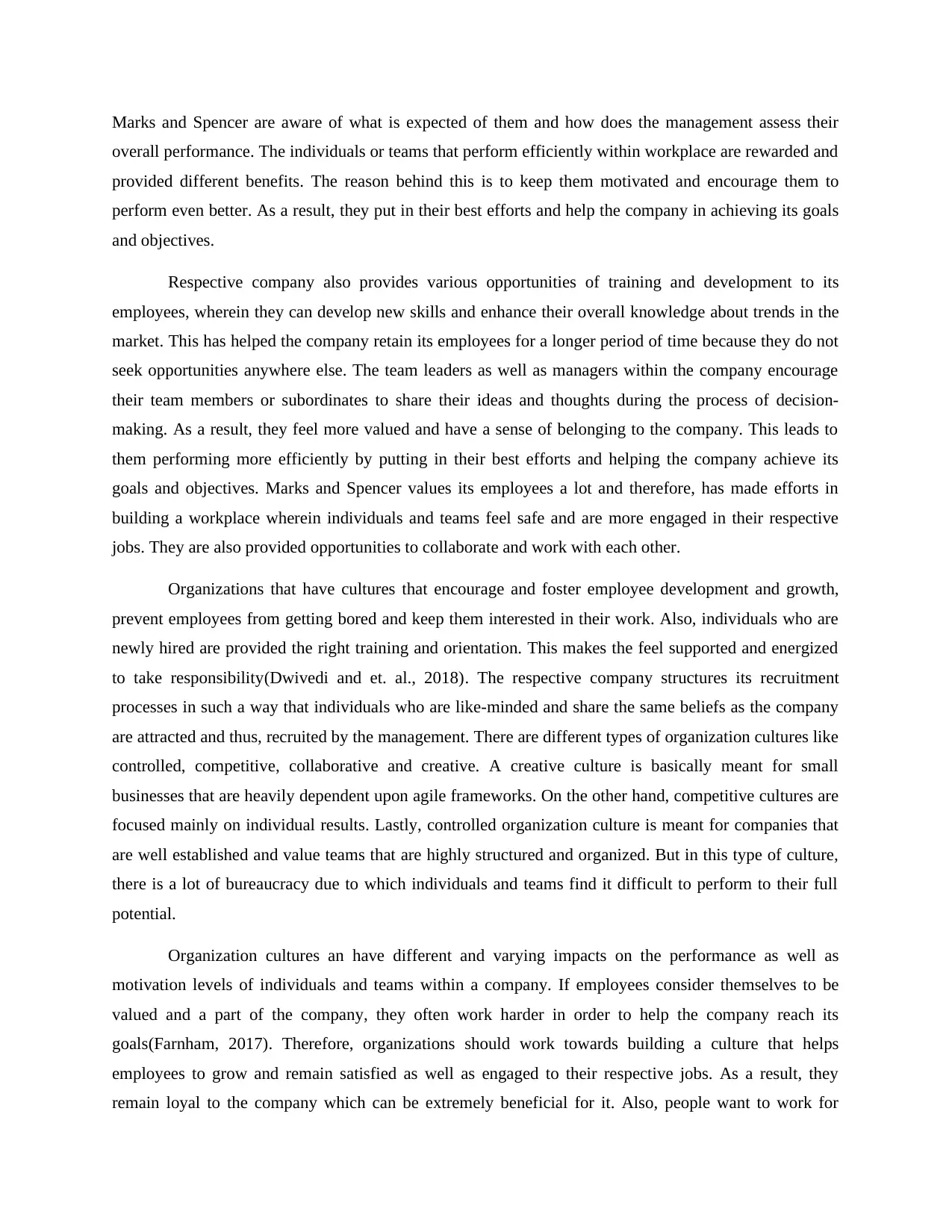
Marks and Spencer are aware of what is expected of them and how does the management assess their
overall performance. The individuals or teams that perform efficiently within workplace are rewarded and
provided different benefits. The reason behind this is to keep them motivated and encourage them to
perform even better. As a result, they put in their best efforts and help the company in achieving its goals
and objectives.
Respective company also provides various opportunities of training and development to its
employees, wherein they can develop new skills and enhance their overall knowledge about trends in the
market. This has helped the company retain its employees for a longer period of time because they do not
seek opportunities anywhere else. The team leaders as well as managers within the company encourage
their team members or subordinates to share their ideas and thoughts during the process of decision-
making. As a result, they feel more valued and have a sense of belonging to the company. This leads to
them performing more efficiently by putting in their best efforts and helping the company achieve its
goals and objectives. Marks and Spencer values its employees a lot and therefore, has made efforts in
building a workplace wherein individuals and teams feel safe and are more engaged in their respective
jobs. They are also provided opportunities to collaborate and work with each other.
Organizations that have cultures that encourage and foster employee development and growth,
prevent employees from getting bored and keep them interested in their work. Also, individuals who are
newly hired are provided the right training and orientation. This makes the feel supported and energized
to take responsibility(Dwivedi and et. al., 2018). The respective company structures its recruitment
processes in such a way that individuals who are like-minded and share the same beliefs as the company
are attracted and thus, recruited by the management. There are different types of organization cultures like
controlled, competitive, collaborative and creative. A creative culture is basically meant for small
businesses that are heavily dependent upon agile frameworks. On the other hand, competitive cultures are
focused mainly on individual results. Lastly, controlled organization culture is meant for companies that
are well established and value teams that are highly structured and organized. But in this type of culture,
there is a lot of bureaucracy due to which individuals and teams find it difficult to perform to their full
potential.
Organization cultures an have different and varying impacts on the performance as well as
motivation levels of individuals and teams within a company. If employees consider themselves to be
valued and a part of the company, they often work harder in order to help the company reach its
goals(Farnham, 2017). Therefore, organizations should work towards building a culture that helps
employees to grow and remain satisfied as well as engaged to their respective jobs. As a result, they
remain loyal to the company which can be extremely beneficial for it. Also, people want to work for
overall performance. The individuals or teams that perform efficiently within workplace are rewarded and
provided different benefits. The reason behind this is to keep them motivated and encourage them to
perform even better. As a result, they put in their best efforts and help the company in achieving its goals
and objectives.
Respective company also provides various opportunities of training and development to its
employees, wherein they can develop new skills and enhance their overall knowledge about trends in the
market. This has helped the company retain its employees for a longer period of time because they do not
seek opportunities anywhere else. The team leaders as well as managers within the company encourage
their team members or subordinates to share their ideas and thoughts during the process of decision-
making. As a result, they feel more valued and have a sense of belonging to the company. This leads to
them performing more efficiently by putting in their best efforts and helping the company achieve its
goals and objectives. Marks and Spencer values its employees a lot and therefore, has made efforts in
building a workplace wherein individuals and teams feel safe and are more engaged in their respective
jobs. They are also provided opportunities to collaborate and work with each other.
Organizations that have cultures that encourage and foster employee development and growth,
prevent employees from getting bored and keep them interested in their work. Also, individuals who are
newly hired are provided the right training and orientation. This makes the feel supported and energized
to take responsibility(Dwivedi and et. al., 2018). The respective company structures its recruitment
processes in such a way that individuals who are like-minded and share the same beliefs as the company
are attracted and thus, recruited by the management. There are different types of organization cultures like
controlled, competitive, collaborative and creative. A creative culture is basically meant for small
businesses that are heavily dependent upon agile frameworks. On the other hand, competitive cultures are
focused mainly on individual results. Lastly, controlled organization culture is meant for companies that
are well established and value teams that are highly structured and organized. But in this type of culture,
there is a lot of bureaucracy due to which individuals and teams find it difficult to perform to their full
potential.
Organization cultures an have different and varying impacts on the performance as well as
motivation levels of individuals and teams within a company. If employees consider themselves to be
valued and a part of the company, they often work harder in order to help the company reach its
goals(Farnham, 2017). Therefore, organizations should work towards building a culture that helps
employees to grow and remain satisfied as well as engaged to their respective jobs. As a result, they
remain loyal to the company which can be extremely beneficial for it. Also, people want to work for
Paraphrase This Document
Need a fresh take? Get an instant paraphrase of this document with our AI Paraphraser
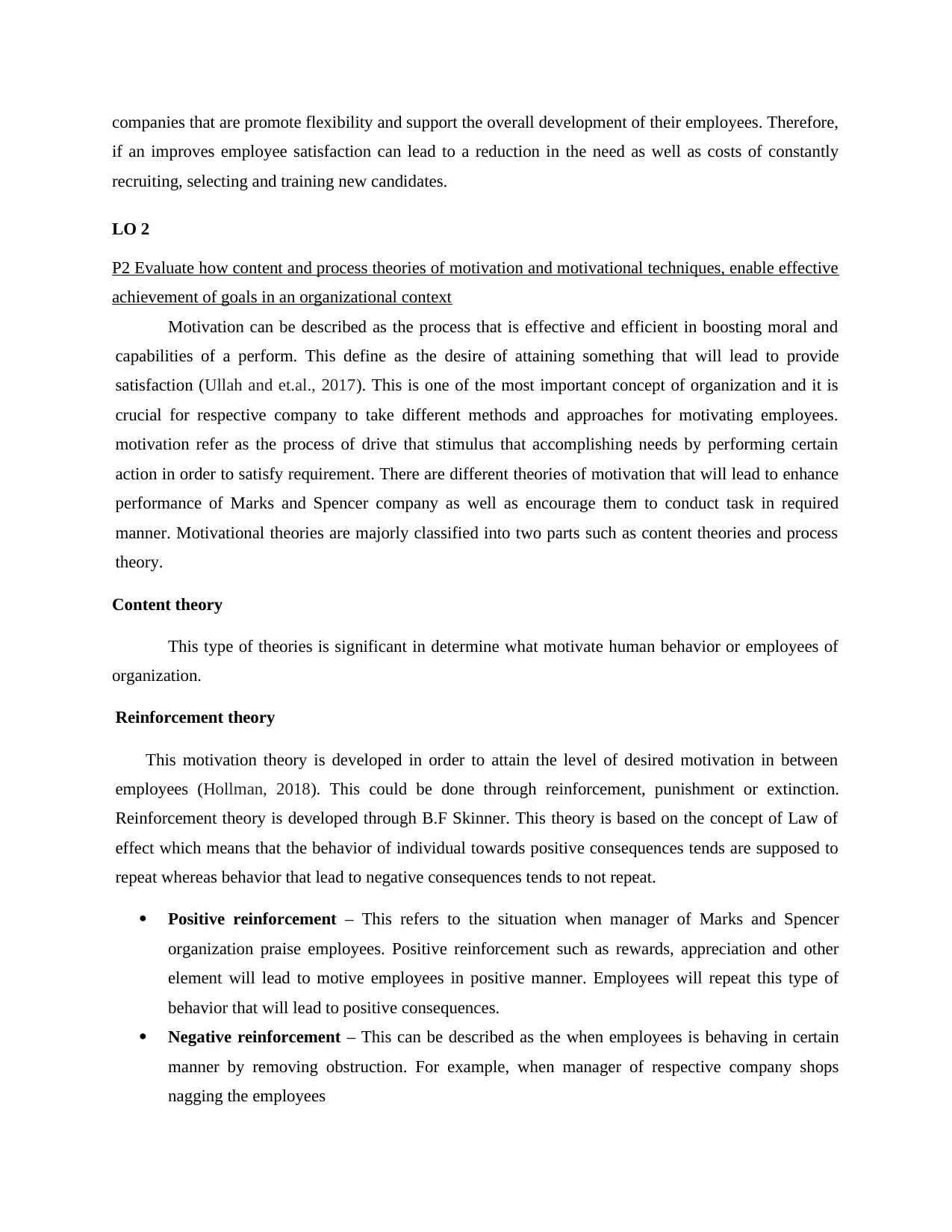
companies that are promote flexibility and support the overall development of their employees. Therefore,
if an improves employee satisfaction can lead to a reduction in the need as well as costs of constantly
recruiting, selecting and training new candidates.
LO 2
P2 Evaluate how content and process theories of motivation and motivational techniques, enable effective
achievement of goals in an organizational context
Motivation can be described as the process that is effective and efficient in boosting moral and
capabilities of a perform. This define as the desire of attaining something that will lead to provide
satisfaction (Ullah and et.al., 2017). This is one of the most important concept of organization and it is
crucial for respective company to take different methods and approaches for motivating employees.
motivation refer as the process of drive that stimulus that accomplishing needs by performing certain
action in order to satisfy requirement. There are different theories of motivation that will lead to enhance
performance of Marks and Spencer company as well as encourage them to conduct task in required
manner. Motivational theories are majorly classified into two parts such as content theories and process
theory.
Content theory
This type of theories is significant in determine what motivate human behavior or employees of
organization.
Reinforcement theory
This motivation theory is developed in order to attain the level of desired motivation in between
employees (Hollman, 2018). This could be done through reinforcement, punishment or extinction.
Reinforcement theory is developed through B.F Skinner. This theory is based on the concept of Law of
effect which means that the behavior of individual towards positive consequences tends are supposed to
repeat whereas behavior that lead to negative consequences tends to not repeat.
Positive reinforcement – This refers to the situation when manager of Marks and Spencer
organization praise employees. Positive reinforcement such as rewards, appreciation and other
element will lead to motive employees in positive manner. Employees will repeat this type of
behavior that will lead to positive consequences.
Negative reinforcement – This can be described as the when employees is behaving in certain
manner by removing obstruction. For example, when manager of respective company shops
nagging the employees
if an improves employee satisfaction can lead to a reduction in the need as well as costs of constantly
recruiting, selecting and training new candidates.
LO 2
P2 Evaluate how content and process theories of motivation and motivational techniques, enable effective
achievement of goals in an organizational context
Motivation can be described as the process that is effective and efficient in boosting moral and
capabilities of a perform. This define as the desire of attaining something that will lead to provide
satisfaction (Ullah and et.al., 2017). This is one of the most important concept of organization and it is
crucial for respective company to take different methods and approaches for motivating employees.
motivation refer as the process of drive that stimulus that accomplishing needs by performing certain
action in order to satisfy requirement. There are different theories of motivation that will lead to enhance
performance of Marks and Spencer company as well as encourage them to conduct task in required
manner. Motivational theories are majorly classified into two parts such as content theories and process
theory.
Content theory
This type of theories is significant in determine what motivate human behavior or employees of
organization.
Reinforcement theory
This motivation theory is developed in order to attain the level of desired motivation in between
employees (Hollman, 2018). This could be done through reinforcement, punishment or extinction.
Reinforcement theory is developed through B.F Skinner. This theory is based on the concept of Law of
effect which means that the behavior of individual towards positive consequences tends are supposed to
repeat whereas behavior that lead to negative consequences tends to not repeat.
Positive reinforcement – This refers to the situation when manager of Marks and Spencer
organization praise employees. Positive reinforcement such as rewards, appreciation and other
element will lead to motive employees in positive manner. Employees will repeat this type of
behavior that will lead to positive consequences.
Negative reinforcement – This can be described as the when employees is behaving in certain
manner by removing obstruction. For example, when manager of respective company shops
nagging the employees
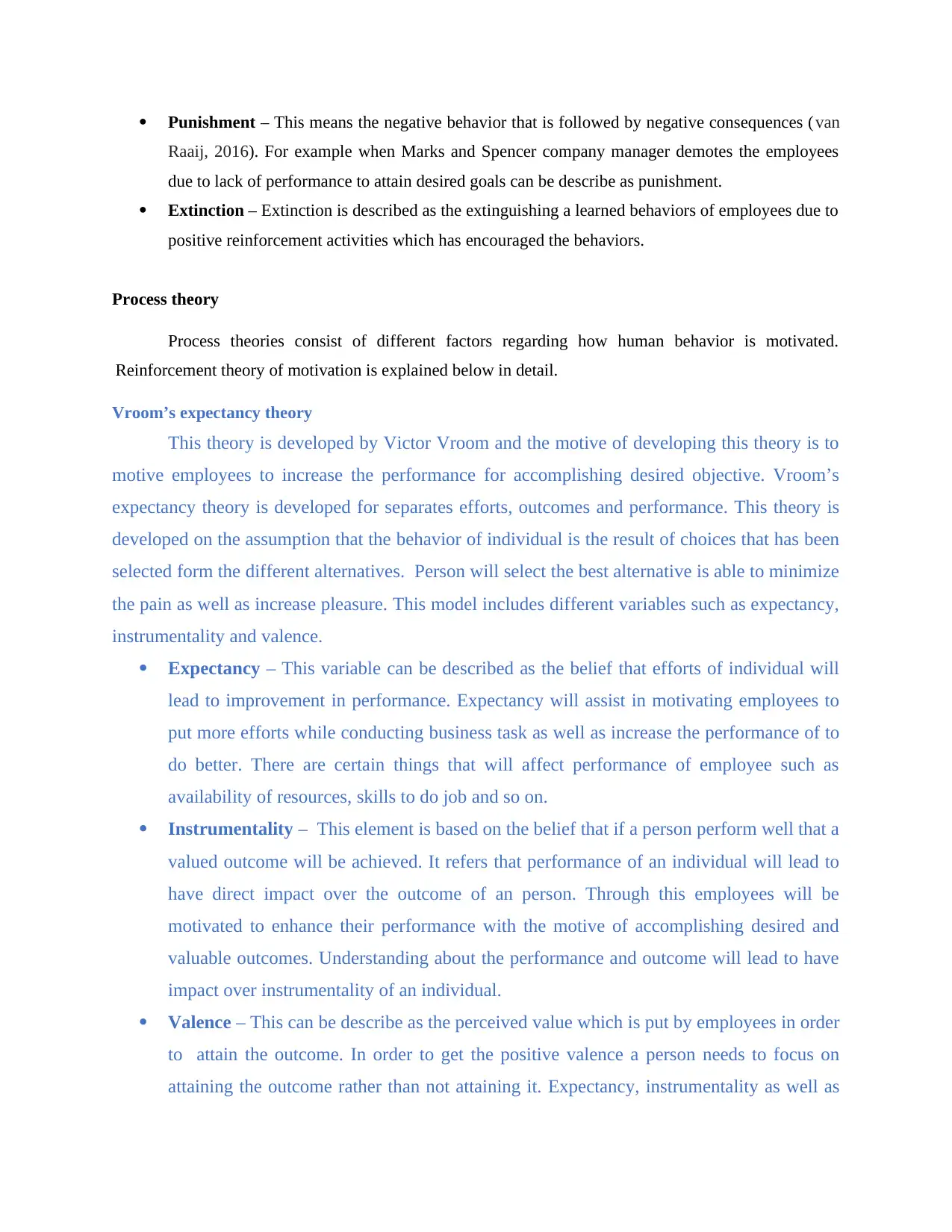
Punishment – This means the negative behavior that is followed by negative consequences (van
Raaij, 2016). For example when Marks and Spencer company manager demotes the employees
due to lack of performance to attain desired goals can be describe as punishment.
Extinction – Extinction is described as the extinguishing a learned behaviors of employees due to
positive reinforcement activities which has encouraged the behaviors.
Process theory
Process theories consist of different factors regarding how human behavior is motivated.
Reinforcement theory of motivation is explained below in detail.
Vroom’s expectancy theory
This theory is developed by Victor Vroom and the motive of developing this theory is to
motive employees to increase the performance for accomplishing desired objective. Vroom’s
expectancy theory is developed for separates efforts, outcomes and performance. This theory is
developed on the assumption that the behavior of individual is the result of choices that has been
selected form the different alternatives. Person will select the best alternative is able to minimize
the pain as well as increase pleasure. This model includes different variables such as expectancy,
instrumentality and valence.
Expectancy – This variable can be described as the belief that efforts of individual will
lead to improvement in performance. Expectancy will assist in motivating employees to
put more efforts while conducting business task as well as increase the performance of to
do better. There are certain things that will affect performance of employee such as
availability of resources, skills to do job and so on.
Instrumentality – This element is based on the belief that if a person perform well that a
valued outcome will be achieved. It refers that performance of an individual will lead to
have direct impact over the outcome of an person. Through this employees will be
motivated to enhance their performance with the motive of accomplishing desired and
valuable outcomes. Understanding about the performance and outcome will lead to have
impact over instrumentality of an individual.
Valence – This can be describe as the perceived value which is put by employees in order
to attain the outcome. In order to get the positive valence a person needs to focus on
attaining the outcome rather than not attaining it. Expectancy, instrumentality as well as
Raaij, 2016). For example when Marks and Spencer company manager demotes the employees
due to lack of performance to attain desired goals can be describe as punishment.
Extinction – Extinction is described as the extinguishing a learned behaviors of employees due to
positive reinforcement activities which has encouraged the behaviors.
Process theory
Process theories consist of different factors regarding how human behavior is motivated.
Reinforcement theory of motivation is explained below in detail.
Vroom’s expectancy theory
This theory is developed by Victor Vroom and the motive of developing this theory is to
motive employees to increase the performance for accomplishing desired objective. Vroom’s
expectancy theory is developed for separates efforts, outcomes and performance. This theory is
developed on the assumption that the behavior of individual is the result of choices that has been
selected form the different alternatives. Person will select the best alternative is able to minimize
the pain as well as increase pleasure. This model includes different variables such as expectancy,
instrumentality and valence.
Expectancy – This variable can be described as the belief that efforts of individual will
lead to improvement in performance. Expectancy will assist in motivating employees to
put more efforts while conducting business task as well as increase the performance of to
do better. There are certain things that will affect performance of employee such as
availability of resources, skills to do job and so on.
Instrumentality – This element is based on the belief that if a person perform well that a
valued outcome will be achieved. It refers that performance of an individual will lead to
have direct impact over the outcome of an person. Through this employees will be
motivated to enhance their performance with the motive of accomplishing desired and
valuable outcomes. Understanding about the performance and outcome will lead to have
impact over instrumentality of an individual.
Valence – This can be describe as the perceived value which is put by employees in order
to attain the outcome. In order to get the positive valence a person needs to focus on
attaining the outcome rather than not attaining it. Expectancy, instrumentality as well as
⊘ This is a preview!⊘
Do you want full access?
Subscribe today to unlock all pages.

Trusted by 1+ million students worldwide
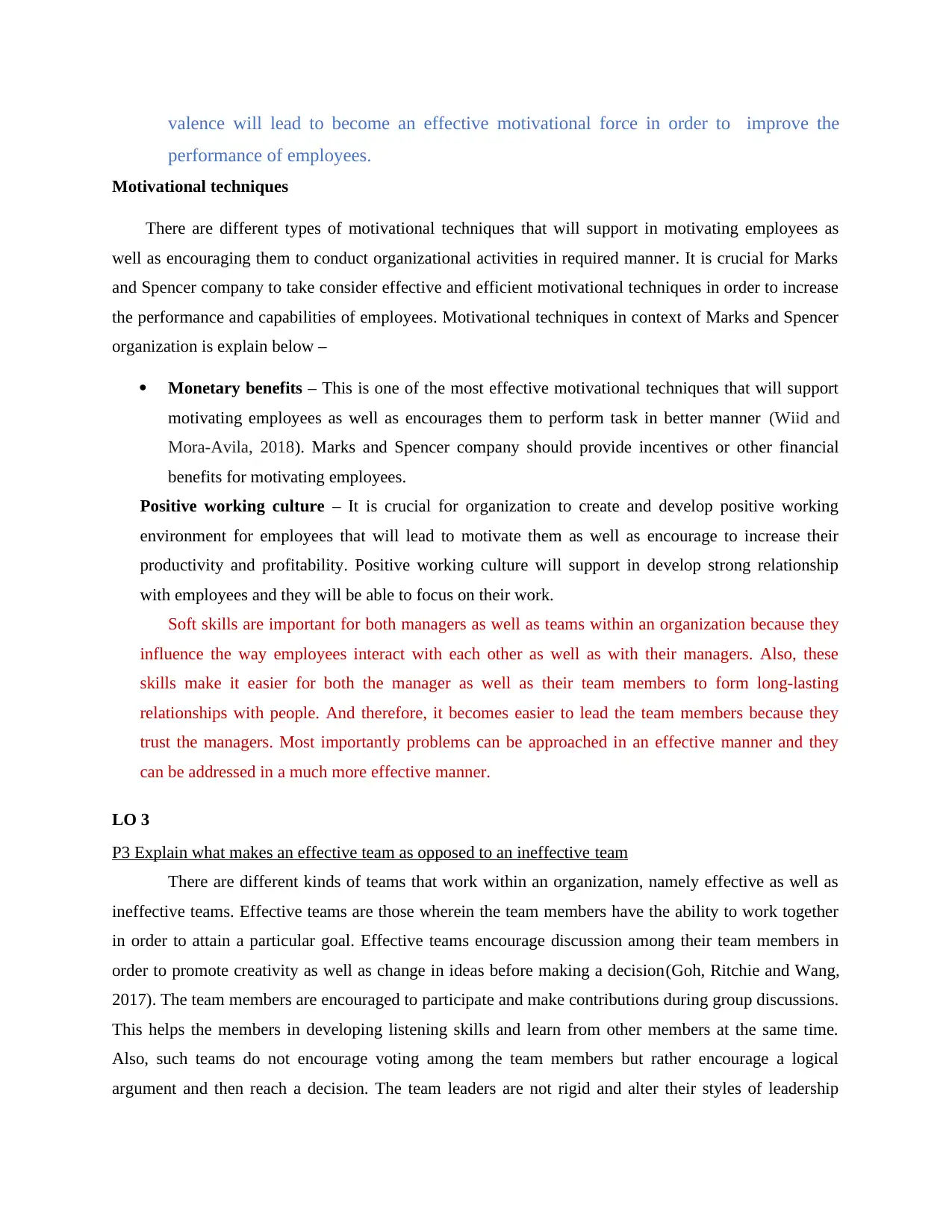
valence will lead to become an effective motivational force in order to improve the
performance of employees.
Motivational techniques
There are different types of motivational techniques that will support in motivating employees as
well as encouraging them to conduct organizational activities in required manner. It is crucial for Marks
and Spencer company to take consider effective and efficient motivational techniques in order to increase
the performance and capabilities of employees. Motivational techniques in context of Marks and Spencer
organization is explain below –
Monetary benefits – This is one of the most effective motivational techniques that will support
motivating employees as well as encourages them to perform task in better manner (Wiid and
Mora‐Avila, 2018). Marks and Spencer company should provide incentives or other financial
benefits for motivating employees.
Positive working culture – It is crucial for organization to create and develop positive working
environment for employees that will lead to motivate them as well as encourage to increase their
productivity and profitability. Positive working culture will support in develop strong relationship
with employees and they will be able to focus on their work.
Soft skills are important for both managers as well as teams within an organization because they
influence the way employees interact with each other as well as with their managers. Also, these
skills make it easier for both the manager as well as their team members to form long-lasting
relationships with people. And therefore, it becomes easier to lead the team members because they
trust the managers. Most importantly problems can be approached in an effective manner and they
can be addressed in a much more effective manner.
LO 3
P3 Explain what makes an effective team as opposed to an ineffective team
There are different kinds of teams that work within an organization, namely effective as well as
ineffective teams. Effective teams are those wherein the team members have the ability to work together
in order to attain a particular goal. Effective teams encourage discussion among their team members in
order to promote creativity as well as change in ideas before making a decision(Goh, Ritchie and Wang,
2017). The team members are encouraged to participate and make contributions during group discussions.
This helps the members in developing listening skills and learn from other members at the same time.
Also, such teams do not encourage voting among the team members but rather encourage a logical
argument and then reach a decision. The team leaders are not rigid and alter their styles of leadership
performance of employees.
Motivational techniques
There are different types of motivational techniques that will support in motivating employees as
well as encouraging them to conduct organizational activities in required manner. It is crucial for Marks
and Spencer company to take consider effective and efficient motivational techniques in order to increase
the performance and capabilities of employees. Motivational techniques in context of Marks and Spencer
organization is explain below –
Monetary benefits – This is one of the most effective motivational techniques that will support
motivating employees as well as encourages them to perform task in better manner (Wiid and
Mora‐Avila, 2018). Marks and Spencer company should provide incentives or other financial
benefits for motivating employees.
Positive working culture – It is crucial for organization to create and develop positive working
environment for employees that will lead to motivate them as well as encourage to increase their
productivity and profitability. Positive working culture will support in develop strong relationship
with employees and they will be able to focus on their work.
Soft skills are important for both managers as well as teams within an organization because they
influence the way employees interact with each other as well as with their managers. Also, these
skills make it easier for both the manager as well as their team members to form long-lasting
relationships with people. And therefore, it becomes easier to lead the team members because they
trust the managers. Most importantly problems can be approached in an effective manner and they
can be addressed in a much more effective manner.
LO 3
P3 Explain what makes an effective team as opposed to an ineffective team
There are different kinds of teams that work within an organization, namely effective as well as
ineffective teams. Effective teams are those wherein the team members have the ability to work together
in order to attain a particular goal. Effective teams encourage discussion among their team members in
order to promote creativity as well as change in ideas before making a decision(Goh, Ritchie and Wang,
2017). The team members are encouraged to participate and make contributions during group discussions.
This helps the members in developing listening skills and learn from other members at the same time.
Also, such teams do not encourage voting among the team members but rather encourage a logical
argument and then reach a decision. The team leaders are not rigid and alter their styles of leadership
Paraphrase This Document
Need a fresh take? Get an instant paraphrase of this document with our AI Paraphraser
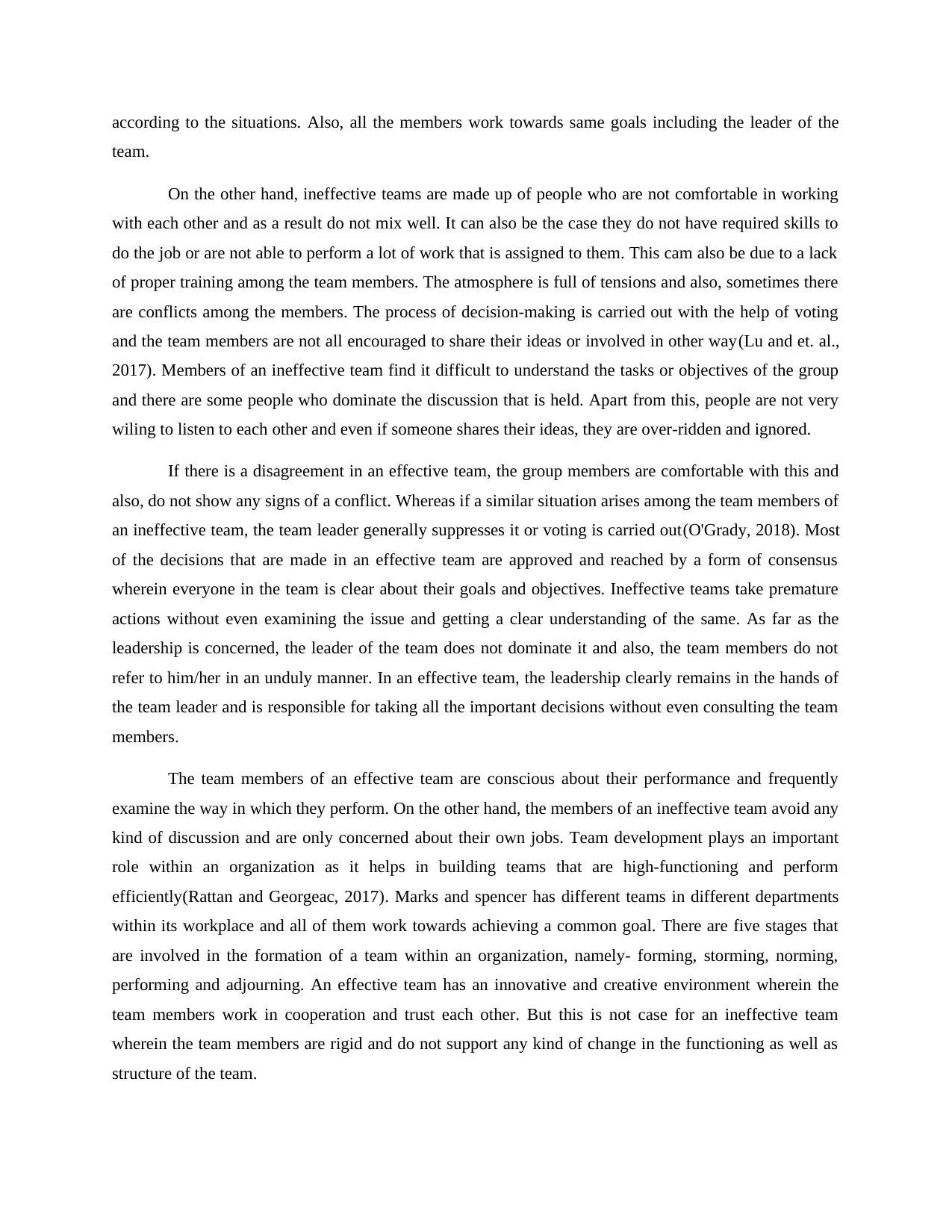
according to the situations. Also, all the members work towards same goals including the leader of the
team.
On the other hand, ineffective teams are made up of people who are not comfortable in working
with each other and as a result do not mix well. It can also be the case they do not have required skills to
do the job or are not able to perform a lot of work that is assigned to them. This cam also be due to a lack
of proper training among the team members. The atmosphere is full of tensions and also, sometimes there
are conflicts among the members. The process of decision-making is carried out with the help of voting
and the team members are not all encouraged to share their ideas or involved in other way(Lu and et. al.,
2017). Members of an ineffective team find it difficult to understand the tasks or objectives of the group
and there are some people who dominate the discussion that is held. Apart from this, people are not very
wiling to listen to each other and even if someone shares their ideas, they are over-ridden and ignored.
If there is a disagreement in an effective team, the group members are comfortable with this and
also, do not show any signs of a conflict. Whereas if a similar situation arises among the team members of
an ineffective team, the team leader generally suppresses it or voting is carried out(O'Grady, 2018). Most
of the decisions that are made in an effective team are approved and reached by a form of consensus
wherein everyone in the team is clear about their goals and objectives. Ineffective teams take premature
actions without even examining the issue and getting a clear understanding of the same. As far as the
leadership is concerned, the leader of the team does not dominate it and also, the team members do not
refer to him/her in an unduly manner. In an effective team, the leadership clearly remains in the hands of
the team leader and is responsible for taking all the important decisions without even consulting the team
members.
The team members of an effective team are conscious about their performance and frequently
examine the way in which they perform. On the other hand, the members of an ineffective team avoid any
kind of discussion and are only concerned about their own jobs. Team development plays an important
role within an organization as it helps in building teams that are high-functioning and perform
efficiently(Rattan and Georgeac, 2017). Marks and spencer has different teams in different departments
within its workplace and all of them work towards achieving a common goal. There are five stages that
are involved in the formation of a team within an organization, namely- forming, storming, norming,
performing and adjourning. An effective team has an innovative and creative environment wherein the
team members work in cooperation and trust each other. But this is not case for an ineffective team
wherein the team members are rigid and do not support any kind of change in the functioning as well as
structure of the team.
team.
On the other hand, ineffective teams are made up of people who are not comfortable in working
with each other and as a result do not mix well. It can also be the case they do not have required skills to
do the job or are not able to perform a lot of work that is assigned to them. This cam also be due to a lack
of proper training among the team members. The atmosphere is full of tensions and also, sometimes there
are conflicts among the members. The process of decision-making is carried out with the help of voting
and the team members are not all encouraged to share their ideas or involved in other way(Lu and et. al.,
2017). Members of an ineffective team find it difficult to understand the tasks or objectives of the group
and there are some people who dominate the discussion that is held. Apart from this, people are not very
wiling to listen to each other and even if someone shares their ideas, they are over-ridden and ignored.
If there is a disagreement in an effective team, the group members are comfortable with this and
also, do not show any signs of a conflict. Whereas if a similar situation arises among the team members of
an ineffective team, the team leader generally suppresses it or voting is carried out(O'Grady, 2018). Most
of the decisions that are made in an effective team are approved and reached by a form of consensus
wherein everyone in the team is clear about their goals and objectives. Ineffective teams take premature
actions without even examining the issue and getting a clear understanding of the same. As far as the
leadership is concerned, the leader of the team does not dominate it and also, the team members do not
refer to him/her in an unduly manner. In an effective team, the leadership clearly remains in the hands of
the team leader and is responsible for taking all the important decisions without even consulting the team
members.
The team members of an effective team are conscious about their performance and frequently
examine the way in which they perform. On the other hand, the members of an ineffective team avoid any
kind of discussion and are only concerned about their own jobs. Team development plays an important
role within an organization as it helps in building teams that are high-functioning and perform
efficiently(Rattan and Georgeac, 2017). Marks and spencer has different teams in different departments
within its workplace and all of them work towards achieving a common goal. There are five stages that
are involved in the formation of a team within an organization, namely- forming, storming, norming,
performing and adjourning. An effective team has an innovative and creative environment wherein the
team members work in cooperation and trust each other. But this is not case for an ineffective team
wherein the team members are rigid and do not support any kind of change in the functioning as well as
structure of the team.
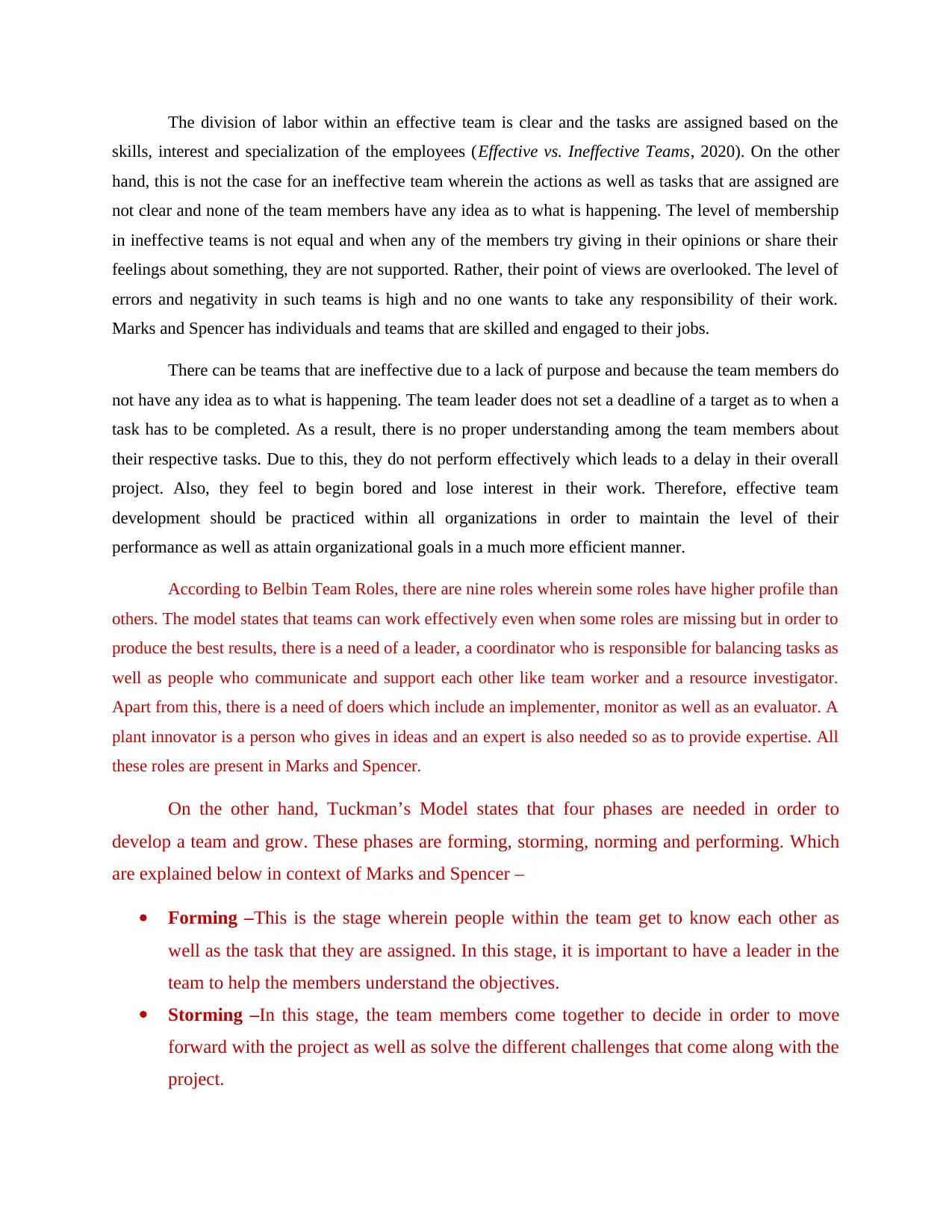
The division of labor within an effective team is clear and the tasks are assigned based on the
skills, interest and specialization of the employees (Effective vs. Ineffective Teams, 2020). On the other
hand, this is not the case for an ineffective team wherein the actions as well as tasks that are assigned are
not clear and none of the team members have any idea as to what is happening. The level of membership
in ineffective teams is not equal and when any of the members try giving in their opinions or share their
feelings about something, they are not supported. Rather, their point of views are overlooked. The level of
errors and negativity in such teams is high and no one wants to take any responsibility of their work.
Marks and Spencer has individuals and teams that are skilled and engaged to their jobs.
There can be teams that are ineffective due to a lack of purpose and because the team members do
not have any idea as to what is happening. The team leader does not set a deadline of a target as to when a
task has to be completed. As a result, there is no proper understanding among the team members about
their respective tasks. Due to this, they do not perform effectively which leads to a delay in their overall
project. Also, they feel to begin bored and lose interest in their work. Therefore, effective team
development should be practiced within all organizations in order to maintain the level of their
performance as well as attain organizational goals in a much more efficient manner.
According to Belbin Team Roles, there are nine roles wherein some roles have higher profile than
others. The model states that teams can work effectively even when some roles are missing but in order to
produce the best results, there is a need of a leader, a coordinator who is responsible for balancing tasks as
well as people who communicate and support each other like team worker and a resource investigator.
Apart from this, there is a need of doers which include an implementer, monitor as well as an evaluator. A
plant innovator is a person who gives in ideas and an expert is also needed so as to provide expertise. All
these roles are present in Marks and Spencer.
On the other hand, Tuckman’s Model states that four phases are needed in order to
develop a team and grow. These phases are forming, storming, norming and performing. Which
are explained below in context of Marks and Spencer –
Forming –This is the stage wherein people within the team get to know each other as
well as the task that they are assigned. In this stage, it is important to have a leader in the
team to help the members understand the objectives.
Storming –In this stage, the team members come together to decide in order to move
forward with the project as well as solve the different challenges that come along with the
project.
skills, interest and specialization of the employees (Effective vs. Ineffective Teams, 2020). On the other
hand, this is not the case for an ineffective team wherein the actions as well as tasks that are assigned are
not clear and none of the team members have any idea as to what is happening. The level of membership
in ineffective teams is not equal and when any of the members try giving in their opinions or share their
feelings about something, they are not supported. Rather, their point of views are overlooked. The level of
errors and negativity in such teams is high and no one wants to take any responsibility of their work.
Marks and Spencer has individuals and teams that are skilled and engaged to their jobs.
There can be teams that are ineffective due to a lack of purpose and because the team members do
not have any idea as to what is happening. The team leader does not set a deadline of a target as to when a
task has to be completed. As a result, there is no proper understanding among the team members about
their respective tasks. Due to this, they do not perform effectively which leads to a delay in their overall
project. Also, they feel to begin bored and lose interest in their work. Therefore, effective team
development should be practiced within all organizations in order to maintain the level of their
performance as well as attain organizational goals in a much more efficient manner.
According to Belbin Team Roles, there are nine roles wherein some roles have higher profile than
others. The model states that teams can work effectively even when some roles are missing but in order to
produce the best results, there is a need of a leader, a coordinator who is responsible for balancing tasks as
well as people who communicate and support each other like team worker and a resource investigator.
Apart from this, there is a need of doers which include an implementer, monitor as well as an evaluator. A
plant innovator is a person who gives in ideas and an expert is also needed so as to provide expertise. All
these roles are present in Marks and Spencer.
On the other hand, Tuckman’s Model states that four phases are needed in order to
develop a team and grow. These phases are forming, storming, norming and performing. Which
are explained below in context of Marks and Spencer –
Forming –This is the stage wherein people within the team get to know each other as
well as the task that they are assigned. In this stage, it is important to have a leader in the
team to help the members understand the objectives.
Storming –In this stage, the team members come together to decide in order to move
forward with the project as well as solve the different challenges that come along with the
project.
⊘ This is a preview!⊘
Do you want full access?
Subscribe today to unlock all pages.

Trusted by 1+ million students worldwide
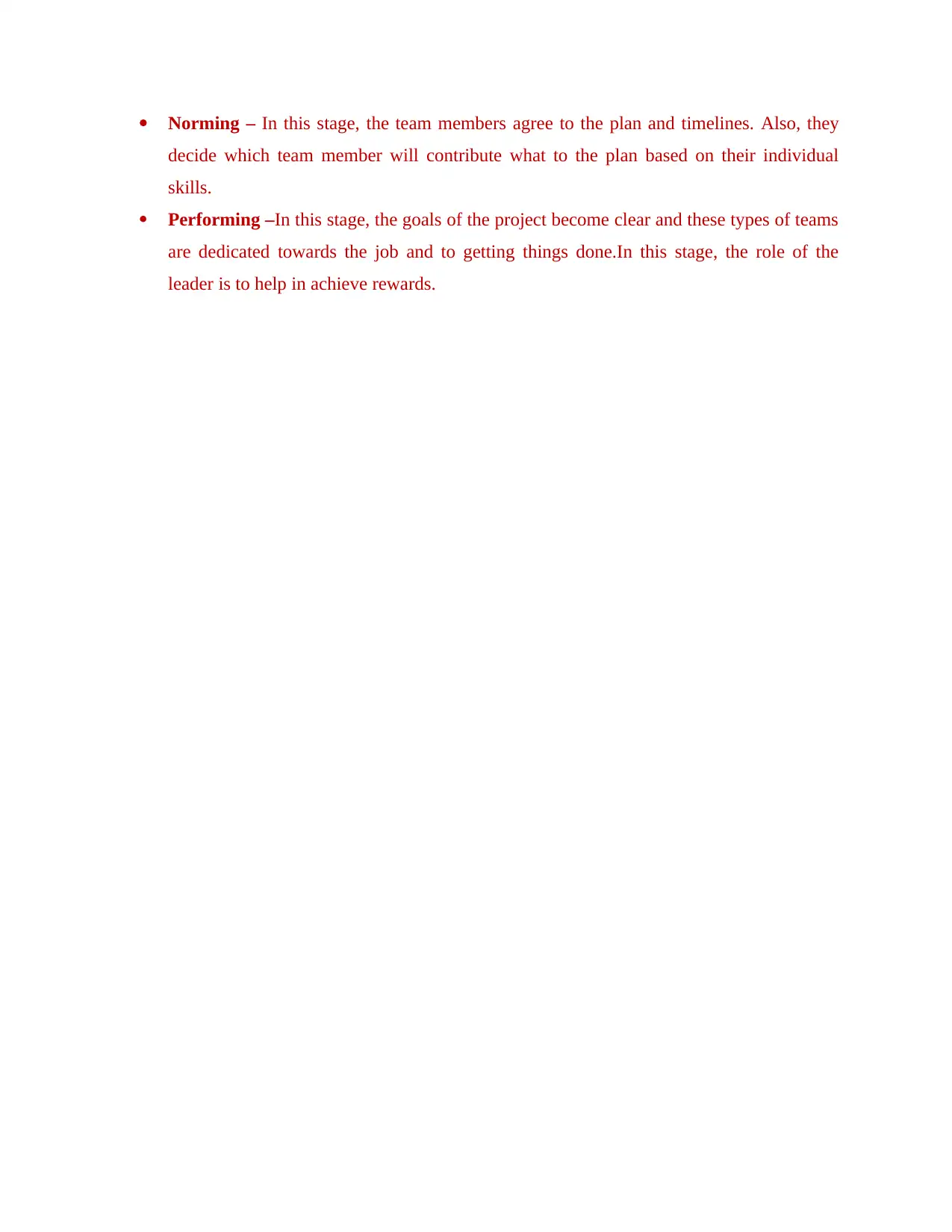
Norming – In this stage, the team members agree to the plan and timelines. Also, they
decide which team member will contribute what to the plan based on their individual
skills.
Performing –In this stage, the goals of the project become clear and these types of teams
are dedicated towards the job and to getting things done.In this stage, the role of the
leader is to help in achieve rewards.
decide which team member will contribute what to the plan based on their individual
skills.
Performing –In this stage, the goals of the project become clear and these types of teams
are dedicated towards the job and to getting things done.In this stage, the role of the
leader is to help in achieve rewards.
Paraphrase This Document
Need a fresh take? Get an instant paraphrase of this document with our AI Paraphraser
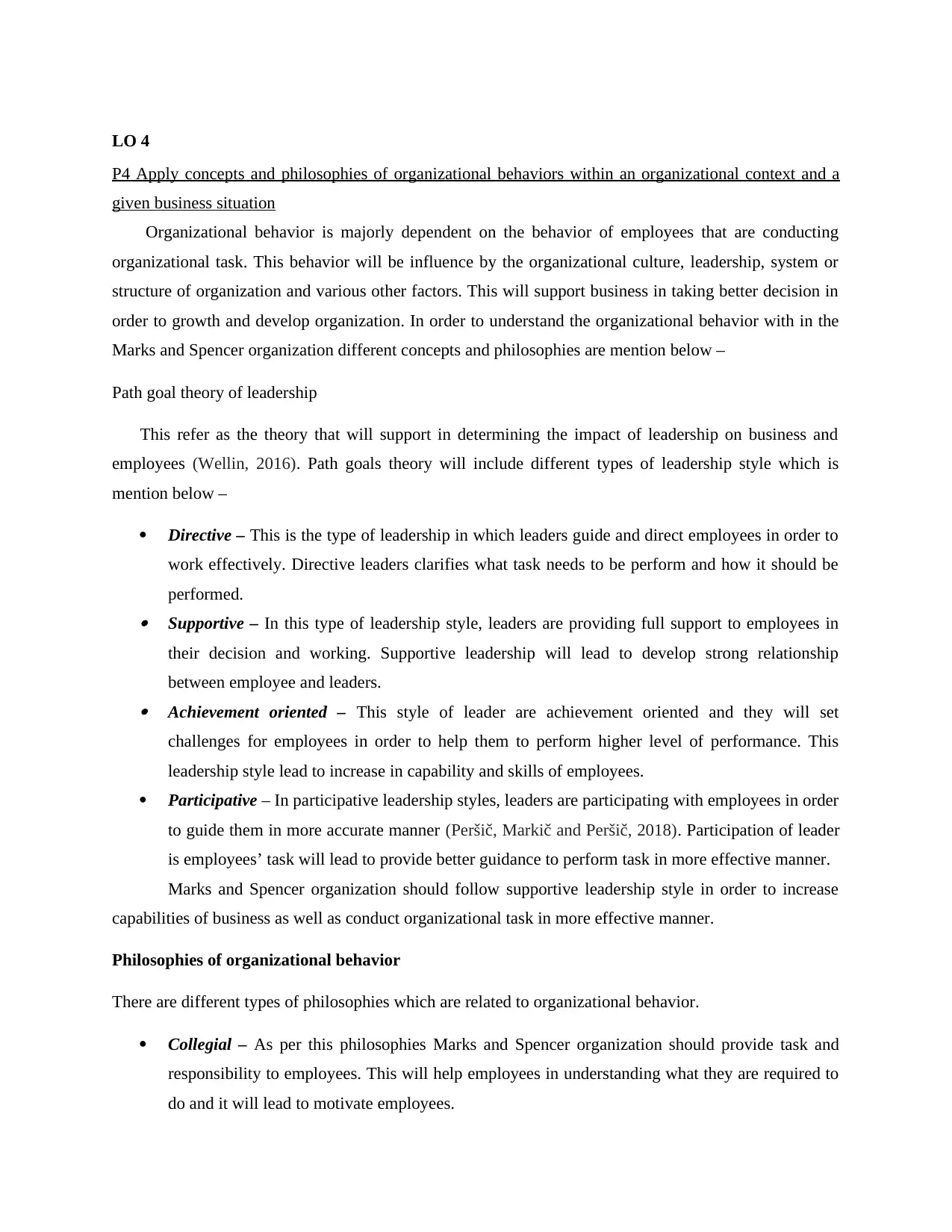
LO 4
P4 Apply concepts and philosophies of organizational behaviors within an organizational context and a
given business situation
Organizational behavior is majorly dependent on the behavior of employees that are conducting
organizational task. This behavior will be influence by the organizational culture, leadership, system or
structure of organization and various other factors. This will support business in taking better decision in
order to growth and develop organization. In order to understand the organizational behavior with in the
Marks and Spencer organization different concepts and philosophies are mention below –
Path goal theory of leadership
This refer as the theory that will support in determining the impact of leadership on business and
employees (Wellin, 2016). Path goals theory will include different types of leadership style which is
mention below –
Directive – This is the type of leadership in which leaders guide and direct employees in order to
work effectively. Directive leaders clarifies what task needs to be perform and how it should be
performed. Supportive – In this type of leadership style, leaders are providing full support to employees in
their decision and working. Supportive leadership will lead to develop strong relationship
between employee and leaders. Achievement oriented – This style of leader are achievement oriented and they will set
challenges for employees in order to help them to perform higher level of performance. This
leadership style lead to increase in capability and skills of employees.
Participative – In participative leadership styles, leaders are participating with employees in order
to guide them in more accurate manner (Peršič, Markič and Peršič, 2018). Participation of leader
is employees’ task will lead to provide better guidance to perform task in more effective manner.
Marks and Spencer organization should follow supportive leadership style in order to increase
capabilities of business as well as conduct organizational task in more effective manner.
Philosophies of organizational behavior
There are different types of philosophies which are related to organizational behavior.
Collegial – As per this philosophies Marks and Spencer organization should provide task and
responsibility to employees. This will help employees in understanding what they are required to
do and it will lead to motivate employees.
P4 Apply concepts and philosophies of organizational behaviors within an organizational context and a
given business situation
Organizational behavior is majorly dependent on the behavior of employees that are conducting
organizational task. This behavior will be influence by the organizational culture, leadership, system or
structure of organization and various other factors. This will support business in taking better decision in
order to growth and develop organization. In order to understand the organizational behavior with in the
Marks and Spencer organization different concepts and philosophies are mention below –
Path goal theory of leadership
This refer as the theory that will support in determining the impact of leadership on business and
employees (Wellin, 2016). Path goals theory will include different types of leadership style which is
mention below –
Directive – This is the type of leadership in which leaders guide and direct employees in order to
work effectively. Directive leaders clarifies what task needs to be perform and how it should be
performed. Supportive – In this type of leadership style, leaders are providing full support to employees in
their decision and working. Supportive leadership will lead to develop strong relationship
between employee and leaders. Achievement oriented – This style of leader are achievement oriented and they will set
challenges for employees in order to help them to perform higher level of performance. This
leadership style lead to increase in capability and skills of employees.
Participative – In participative leadership styles, leaders are participating with employees in order
to guide them in more accurate manner (Peršič, Markič and Peršič, 2018). Participation of leader
is employees’ task will lead to provide better guidance to perform task in more effective manner.
Marks and Spencer organization should follow supportive leadership style in order to increase
capabilities of business as well as conduct organizational task in more effective manner.
Philosophies of organizational behavior
There are different types of philosophies which are related to organizational behavior.
Collegial – As per this philosophies Marks and Spencer organization should provide task and
responsibility to employees. This will help employees in understanding what they are required to
do and it will lead to motivate employees.
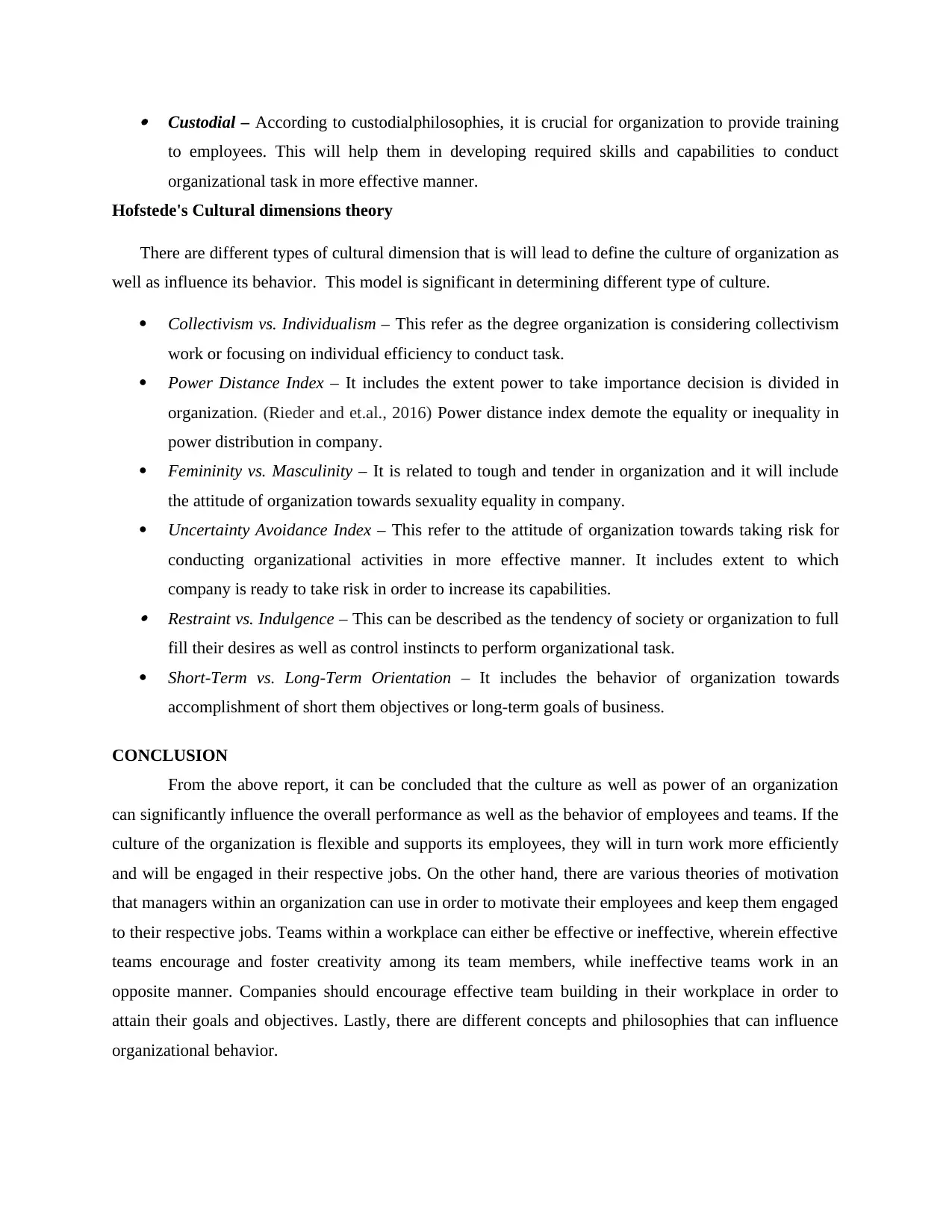
Custodial – According to custodialphilosophies, it is crucial for organization to provide training
to employees. This will help them in developing required skills and capabilities to conduct
organizational task in more effective manner.
Hofstede's Cultural dimensions theory
There are different types of cultural dimension that is will lead to define the culture of organization as
well as influence its behavior. This model is significant in determining different type of culture.
Collectivism vs. Individualism – This refer as the degree organization is considering collectivism
work or focusing on individual efficiency to conduct task.
Power Distance Index – It includes the extent power to take importance decision is divided in
organization. (Rieder and et.al., 2016) Power distance index demote the equality or inequality in
power distribution in company.
Femininity vs. Masculinity – It is related to tough and tender in organization and it will include
the attitude of organization towards sexuality equality in company.
Uncertainty Avoidance Index – This refer to the attitude of organization towards taking risk for
conducting organizational activities in more effective manner. It includes extent to which
company is ready to take risk in order to increase its capabilities. Restraint vs. Indulgence – This can be described as the tendency of society or organization to full
fill their desires as well as control instincts to perform organizational task.
Short-Term vs. Long-Term Orientation – It includes the behavior of organization towards
accomplishment of short them objectives or long-term goals of business.
CONCLUSION
From the above report, it can be concluded that the culture as well as power of an organization
can significantly influence the overall performance as well as the behavior of employees and teams. If the
culture of the organization is flexible and supports its employees, they will in turn work more efficiently
and will be engaged in their respective jobs. On the other hand, there are various theories of motivation
that managers within an organization can use in order to motivate their employees and keep them engaged
to their respective jobs. Teams within a workplace can either be effective or ineffective, wherein effective
teams encourage and foster creativity among its team members, while ineffective teams work in an
opposite manner. Companies should encourage effective team building in their workplace in order to
attain their goals and objectives. Lastly, there are different concepts and philosophies that can influence
organizational behavior.
to employees. This will help them in developing required skills and capabilities to conduct
organizational task in more effective manner.
Hofstede's Cultural dimensions theory
There are different types of cultural dimension that is will lead to define the culture of organization as
well as influence its behavior. This model is significant in determining different type of culture.
Collectivism vs. Individualism – This refer as the degree organization is considering collectivism
work or focusing on individual efficiency to conduct task.
Power Distance Index – It includes the extent power to take importance decision is divided in
organization. (Rieder and et.al., 2016) Power distance index demote the equality or inequality in
power distribution in company.
Femininity vs. Masculinity – It is related to tough and tender in organization and it will include
the attitude of organization towards sexuality equality in company.
Uncertainty Avoidance Index – This refer to the attitude of organization towards taking risk for
conducting organizational activities in more effective manner. It includes extent to which
company is ready to take risk in order to increase its capabilities. Restraint vs. Indulgence – This can be described as the tendency of society or organization to full
fill their desires as well as control instincts to perform organizational task.
Short-Term vs. Long-Term Orientation – It includes the behavior of organization towards
accomplishment of short them objectives or long-term goals of business.
CONCLUSION
From the above report, it can be concluded that the culture as well as power of an organization
can significantly influence the overall performance as well as the behavior of employees and teams. If the
culture of the organization is flexible and supports its employees, they will in turn work more efficiently
and will be engaged in their respective jobs. On the other hand, there are various theories of motivation
that managers within an organization can use in order to motivate their employees and keep them engaged
to their respective jobs. Teams within a workplace can either be effective or ineffective, wherein effective
teams encourage and foster creativity among its team members, while ineffective teams work in an
opposite manner. Companies should encourage effective team building in their workplace in order to
attain their goals and objectives. Lastly, there are different concepts and philosophies that can influence
organizational behavior.
⊘ This is a preview!⊘
Do you want full access?
Subscribe today to unlock all pages.

Trusted by 1+ million students worldwide
1 out of 14
Related Documents
Your All-in-One AI-Powered Toolkit for Academic Success.
+13062052269
info@desklib.com
Available 24*7 on WhatsApp / Email
![[object Object]](/_next/static/media/star-bottom.7253800d.svg)
Unlock your academic potential
Copyright © 2020–2025 A2Z Services. All Rights Reserved. Developed and managed by ZUCOL.





